Hello and welcome!
Anyone who has visited the Cathedral recently will notice that we’ve been doing some sprucing up.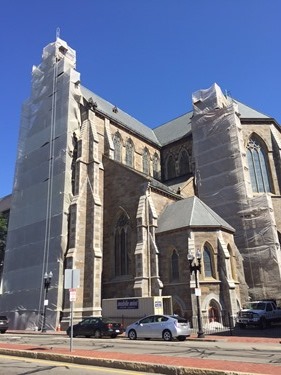
Father Kevin O’Leary established a committee to raise funds to clean and re-point the exterior of the Cathedral and to make repairs on the roof. And install new bells as well. The work has begun and will be completed in the next few months but the difference is absolutely stunning.
As you can see in this photo of a section that has been partially cleaned, the difference is tremendous.
In this photo from the back of the church you can see a section that has already been done. 

This is the first time in 150 years at the Cathedral has been cleaned in this way — and, as we like to say around here, it’s good to clean it every 150 years, whether it needs it or not!
I think the Catholics of the archdiocese will be very proud of their Cathedral once all the work is complete. We are very grateful to Father O’Leary and all those who have collaborated with him on this very important endeavor.
– – –
Also this week, the U.S. conference of Catholic Bishops weighed in on the current controversy surrounding Planned Parenthood with a letter that I, as chairman of the Committee on Pro-Life Activities, sent out to senators explaining the Church’s objections to Planned Parenthood’s activities, particularly in regard to the latest revelations that they are harvesting organs from aborted children and selling them.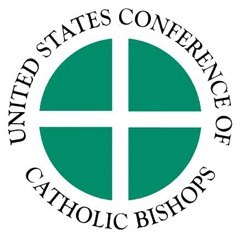
It is curious that many of the same people who claim that an unborn child is simply part of the mother’s body or merely a lump of tissue are very quick to recognize that the unborn child has human organs that can be sold. So, in many ways it is diminishing the humanity of these children while, at the same time, recognizing that they are in fact human beings.
– – –
On Friday, I attended the funeral for Cardinal Baum who was probably the oldest living American Cardinal, and almost all the U.S. Cardinals were there for his funeral.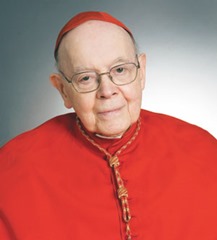
Cardinal Wuerl gave a very beautiful homily, in which he talked about the long ministry of Cardinal Baum, beginning with his involvement in the ecumenical movement that came out of his own experience. His father was a Protestant and, when his father died his mother married a Jewish gentleman. So, in his own family he had these relationships and was able to do so much in those post- conciliar days to promote ecumenism and interreligious dialogue.
As I have mentioned before, he became Archbishop of Washington at a time when there was great controversy and division, but in his characteristic and gentlemanly way he brought a sense of serenity and reconciliation into the archdiocese. Later he went on to serve in Rome for many years. There have actually been three Archbishops in Washington since his tenure, because the longest part of his ministry as a Cardinal was heading up the Congregation for Catholic Education and later the Tribunal of the Apostolic Penitentiary.
I’d like to share Cardinal Wuerl’s homily with you here: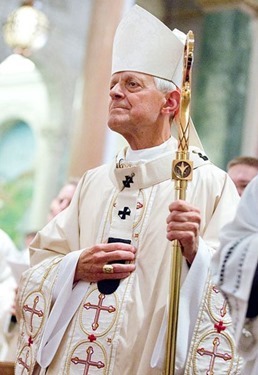
Dear brothers and sisters in the Lord:
One week ago, William Wakefield Baum, Cardinal Priest of the Holy Roman Church and titular of the Church of the Holy Cross in Via Flaminia in Rome, was called to the Father’s house. In response to the call, he passed through the doors of death in anticipation of the life to come.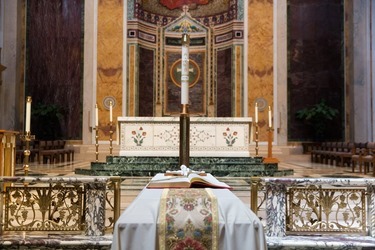
We gather today so that we might with faith in the Resurrection of Jesus Christ from the dead and his pledge to us of new life remember and celebrate the life and ministry of Cardinal Baum, thank God for it and pray to God for our dear beloved pastor and friend.
The first reading today is taken from the Prophet Isaiah and speaks of that day when we will rejoice as we stand before God, all our tears will be wiped away and we will see the Lord and be glad and rejoice in him. Saint Paul expands on this hope-filled expectation. No longer shall we see God merely by faith, but we shall see him “face to face” (1 Cor 13:12).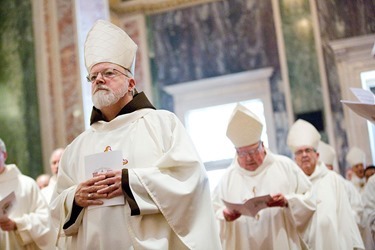
This reading was explicitly chosen because some months ago I had a conversation, one of many, with Cardinal Baum at his residence at the Little Sisters of the Poor. The fact that he was able, at the Jeanne Jugan Residence, to continue to receive visitors and have conversations with the same style and ease as he did at his apartment in Rome and later on his retirement here is a tribute to the care and love provided by the Little Sisters.
This time Cardinal Baum raised the question of the beatific vision. There are few people whom I visit with the infirmities he bore who continue to have such a range of interests. All of us who spoke with His Eminence know that his conversations could go from questions about what is happening in the Church today, to reflections on the current culture and, as often as not, to theological matters. This particular day we reflected on what it will mean to say we see God face to face. I have to admit that the question caught me a little off guard and I immediately began mentally to retrieve my old university theology notes.
After some time, we concluded that the only thing we can be certain of is that in God’s mercy there will be such an encounter and that the nature of it is something we will simply have to await.
Now he knows the answer. As Isaiah reminds us, it is in God’s presence prefigured by his holy mountain that the Lord of hosts will destroy the veil that separates us from the face of God.
Cardinal Baum was a man of faith who many times in his life heard God’s call and responded. His journey as a disciple began with a call that was heard not so much with his ears but with his soul. It was in the baptismal outpouring of the waters of salvation that he responded to the call to a new way of life. He began a journey that only over time would he become more and more aware of, committed to and live.
In the second reading we are told that those who are baptized into Christ Jesus are baptized into his death but also into newness of life. “We who are baptized into Christ Jesus were baptized into his death…so that just as Christ was raised from the dead…we too might live in newness of life” (Rom 6:34).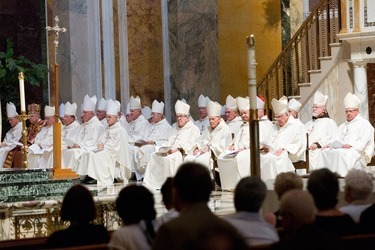
It was his profound faith in this call that was at the very core of Cardinal William Baum. In this Liturgy, as with all who have been baptized, the Church fondly prays for William. In the waters in the font of salvation we all become simply children of God. All of the accomplishments of life and all the honors and dignities, civil and ecclesiastical, however earned and merited, pale before the designation that in baptism we become adopted children of God.
Saint Paul confirms this unique Christian vocation, “The spirit itself bears witness with our spirit that we are children of God, and if children, then heirs, heirs of God and joint heirs with Christ…so that we might also be glorified with him” (Rom 8:16-17).
As a man of faith, William Wakefield Baum recognized the special role of the Church in this process of adoption and transformation. In the Creed we profess our faith in the Father, the Son, the Holy Spirit and the one, holy, catholic and apostolic Church. It was the wonder of incorporation into the Body of Christ that guided so much of the vision and activity of our late archbishop and cardinal.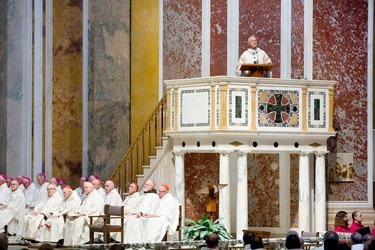
The Second Vatican Council Dogmatic Constitution on the Church describes this vision that captivated the imagination and heart of Cardinal Baum over fifty years ago. “For by communicating his Spirit, Christ mystically constitutes as his Body those brothers of his who are called together from every nation” (L.G. 7).
His ecumenical vision was nurtured by this call to communion. It also grew out of his own personal experience. With a Protestant father and a Jewish step-father, Cardinal Baum was profoundly aware of the implications of interfaith and ecumenical relations. This experience colored his priestly ministry.
In his thirties he was already recognized as one of the Catholic Church’s authorities on interfaith relations. We all with great pride can recall how during the Second Vatican Council Cardinal Baum served as advisor on ecumenical matters to the Fathers of the Council. He was engaged in some of the work in developing drafts of documents that helped reshape the Church’s appreciation of ecumenical and interfaith relations.
Here in Washington he had ample opportunity to apply the new perspectives and directives. From the end of the Council until 1967, the then Monsignor Baum was the first Executive Director of the Bishops’ Committee on Ecumenical and Interreligious Affairs. Closer to home, he was one of the co-founders of the Interfaith Conference of Metropolitan Washington. This was one of the first such institutions in our nation bringing together leadership of many religious traditions.
His life might well be described as some have as scholarly, quiet and cultured. I would add another adjective, “serene.” His serenity came from his profound conviction that the Church is the living presence of Christ in the world and that our efforts to serve the Church and to be open to our brothers and sisters who have different faith convictions is a mark of an adopted child of God.
In this Cathedral Church are many who can attest to the quiet, profound and absolutely unshakable faith in the Church as part of God’s plan that marked the life of Cardinal Baum.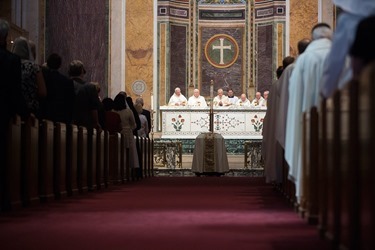
His episcopal ministry began in the Diocese of Springfield-Cape Girardeau and continued later with his 1973 transfer to lead the Archdiocese of Washington. This was not a quiet time in the life of the Church. He spoke then about the need to bring healing and unity to a Church that was divided in its clergy and faithful over the encyclical of Pope, now Blessed, Paul VI, Humanae Vitae. Some who objected to this teaching asserted that it was an overreach of Papal Magisterium because it dealt with matters that were less than dogmatic. There were those who insisted that it clearly did not enjoy the approbation of those who had expertise in this field. Yet the overriding vision of Cardinal Baum was to do everything possible to sustain and maintain the unity of God’s family.
His episcopal motto, which was drawn from Saint Paul’s Second Letter to the Corinthians, was “Ministerium reconciliationis” — a ministry of reconciliation.
His was a ministry of engagement not confrontation. Nowhere was this more evident than in his ministry here in this archdiocese.
From 1973 to 1980 he carried out this ministry as our archbishop. During those days I came to know him primarily through the work on the catechism, The Teaching of Christ. This was an adult catechism published several decades before the Catechism of the Catholic Church. I recall with affection visiting Cardinal Baum with Capuchin Father Ronald Lawler, God rest him, to ask advice about the possibility of such an adult catechism and how it would be developed. His immediate response was to highlight two elements: the Church as God’s instrument among us, and the need for an ecumenical outreach to try to restore the unity of that Church.
It was during his tenure as our Cardinal Archbishop that he welcomed Pope John Paul II to the capital of our nation during his historic first pastoral visit in 1979.
His deep faith in the Church as the living presence of Christ in the world and the manifestation of God’s kingdom coming to be in our time, I think, is the most remarkable characteristic of Cardinal William Baum. This identification led him gladly to accept the change in responsibilities that caused him to step aside from his beloved ministry in Washington and go to Rome.
Here in 1980 he became the Prefect of the Vatican Congregation for Catholic Education where for ten years he oversaw seminaries and Catholic colleges and universities around the world. Here again, his motto of a ministry of reconciliation was evident. As head of the Vatican Office for Education, he was responsible for oversight and relations with Catholic colleges and universities throughout the world. He met regularly and continually with the leadership of Catholic higher education during a decade that witnessed the significant realignment of university governance and structures that continues to be operative today.
Once again, our paths would cross as Pope, now Saint, John Paul II entrusted to Cardinal Baum the apostolic visitation of all of the 220 seminaries and houses of formation in the United States. I had the great privilege of serving under the direction of Cardinal Baum in this vast effort. In every step on that six year process he was involved and encouraging. For him, the institutions of the Church were the manifestations of the life of the Church. Maybe this is why he also served as a member of the Congregation for Bishops, Oriental Churches, Consecrated Life and Societies of Apostolic Life, and the Evangelization of Peoples.
Underlining this diversity of assignments was Cardinal Baum’s total dedication to a single vision — the vision of the priesthood as Christ at work in the world and his personal, firm commitment to serve the Lord as his priest, which he did for 64 years. He lived the words of today’s Responsorial Psalm, “The Lord is my light and my salvation” (Psalm 27). In that light, he responded faithfully to the call to become an image of Jesus, dedicated to maintaining Christ’s love and teaching, leading and sanctifying those entrusted to his care.
How appropriate that after a decade of service overseeing the universities, colleges and seminaries throughout the world Cardinal Baum would become the head of the Vatican Sacred Penitentiary, that office that oversees the realm of sacred space where conscience gives unto the very presence of God in our lives.
I do not know what goes on at the Sacred Penitentiary because it was a topic that Cardinal Baum never addressed. Matters of conscience, privacy, confidentiality were realities he held dear and sacred.
In our day where confidentiality and the respect for others have so greatly diminished, his ministry can be a model for many of us.
His personal spiritual life was focused on the Eucharist, the Blessed Sacrament. Many of us can remember seeing him at his apartment in Rome or his various residences here in this archdiocese and the visit to the Blessed Sacrament before and after lunch. His prayer that we shared was a very simply one: O Sacrament most holy, O Sacrament divine, all praise and all thanksgiving be every moment thine.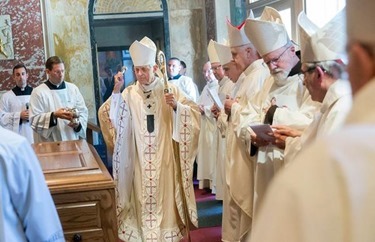
To this day when I say that prayer I can still hear his quiet and gentle voice.
At the heart of all of his wisdom, humility and dedication was the faith of one who experienced and encountered the living Lord.
The Gospel today tells us of that encounter, the encounter between Martha and Jesus at the death of Lazarus. Jesus reminds her that “your brother will rise.” But she replies, “I know he will rise, in the resurrection on the last day.” Jesus retort is clear and simple, “I am the resurrection and the life; whoever believes in me, even if he dies, will live, and everyone who lives and believes in me will never die,” and then he asked her, “Do you believe this?”
Her answer, the answer of William Baum, the answer of his Eminence Cardinal William Wakefield Baum, the answer to the faithful gathered in this Church today is the same, “Yes Lord. I have come to believe that you are the Messiah, the Son of God, the one who is coming into the world.”
Those who come to eternal life will enjoy every manner of blessing but at the core of their joy will be the possession of God himself. No longer shall we see God merely by faith, but we shall see him “face to face” (1 Cor. 13:12). It is in that expectation that we pray that we will hear these words of our Lord at our own judgment and pray that it is also the invitation directed now to Cardinal Baum, “Come share your master’s joy” (Mt. 25: 21).
This brings us back to where we began — Cardinal Baum’s room at the Little Sisters of the Poor.
I will always carry in my mind’s eye the scene at his deathbed as together with the Little Sisters of the Poor we offered the prayers for the dying. I administered the apostolic absolution. He had been many times anointed, several times by myself, and most recently by his faithful secretary Monsignor Patrick E. Dempsey.
The Little Sisters who had so well cared for our Cardinal and who do so for so many with such great love gathered around the bed and prayed. I can easily recall the tears in the eyes of some of the sisters who also saw with the eyes of faith and love that it was a holy passing that we were witnessing.
My brothers and sisters, that holy passing is what we also witness. Those tears are wiped away today. We pray with confidence that our brother now may enter the presence of God whom he now sees face to face.
May his life be a blessing for all of us, may his witness be an example to each of us and may his faith and ours be the force that wipes away our tears in anticipation of when we too hope to see God face to face.
Thank you.
– – –
Following the funeral, I went to Philadelphia for the annual Supreme Convention of the Knights of Columbus.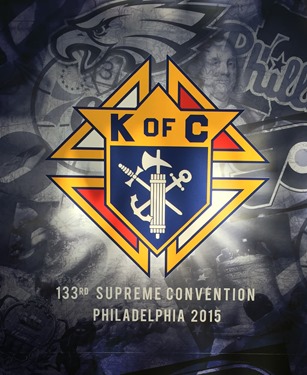

We had a very good representation from the Archdiocese of Boston.
I was very happy to see Father Bob Reed and the folks from CatholicTV at the convention providing coverage of this important event.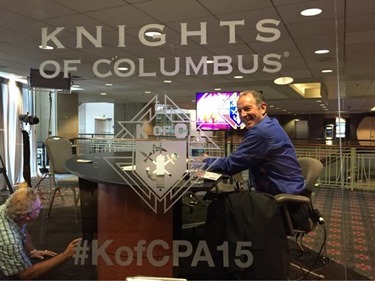
Bishop Uglietto and Bishop Kennedy were also able to join us though Bishop Hennessey had to return early for the funeral of the mother of Father Wayne Belschner.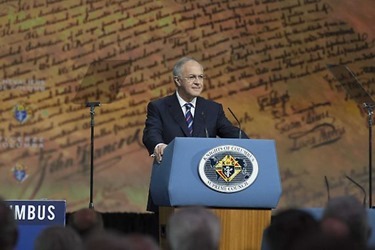
The theme of the convention, “Endowed by their Creator with Life And Liberty” was inspired by the words from the Declaration of Independence, which was of course signed in Philadelphia. In keeping with the theme, many of the talks addressed the subject of religious freedom, including the report of the Supreme Knight, Carl Anderson. 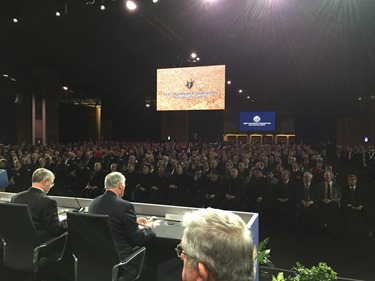
He spoke about one of the Grand Knights who, during the Cristiada War, spoke out against the persecution of Catholics in Mexico, lamenting the fact that no one was mentioning this problem at the time. He said that today we have a similar problem in Eastern Europe. 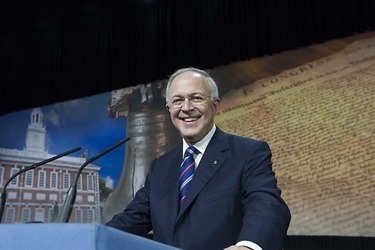
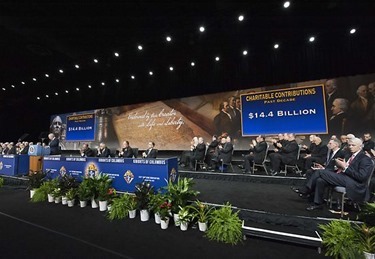
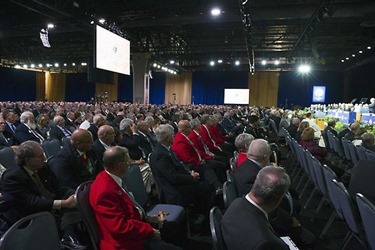
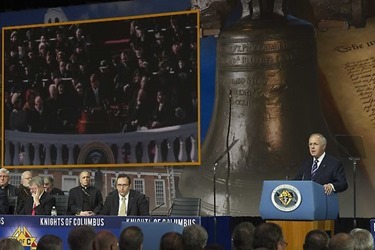
In this picture we see the Knights holding up a wooden cross. They gave these wooden crosses, made of olive wood from the Holy Land, to everyone. This is a new initiative of Knights of Columbus to raise money to support the Catholics in the Middle East. 
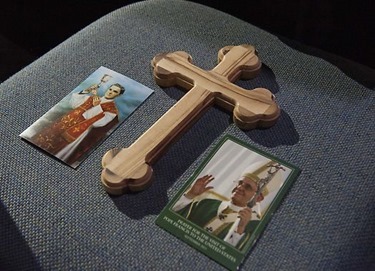 The Supreme Knight also reviewed some of the works the Knights have carried out over the last year, which included $173 million in charitable donations as well as over 71 million volunteer hours. He also reported that The Knights of Columbus had a very large increase in membership last year, adding 256 new councils with a membership of almost 2 million overall.
The Supreme Knight also reviewed some of the works the Knights have carried out over the last year, which included $173 million in charitable donations as well as over 71 million volunteer hours. He also reported that The Knights of Columbus had a very large increase in membership last year, adding 256 new councils with a membership of almost 2 million overall.
I’m very anxious for us to do more to promote membership of the Knights of Columbus in Massachusetts. One of the things that Carl Anderson asked was that over the next year each Knight should bring in three new members. I want to echo that call. When a parish sets up a council it becomes an instant way of achieving men’s ministry in the parish. In addition it’s a great help to the pastor.
– – –


This year at the States Banquet, instead of the typical keynote they had the two bishops from the Middle East, where the Church is so persecuted, give witness talks about the situation of the Church in their countries.

– – –
The Supreme Convention is always an inspiring occasion. But one of the events that particularly struck me this year was our celebration Wednesday of the Divine Liturgy of St. John Chrysostom yesterday in solidarity with the people of the Ukraine.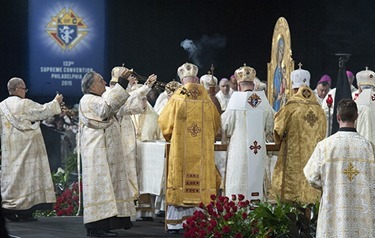
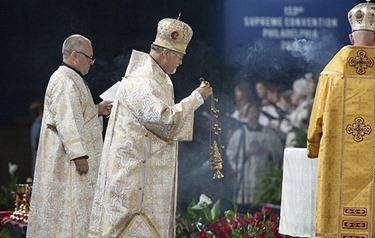
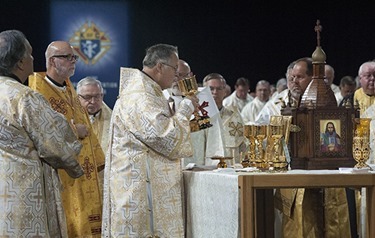
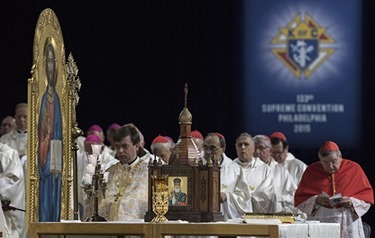
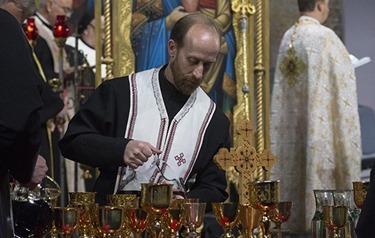
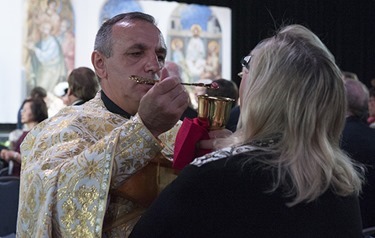
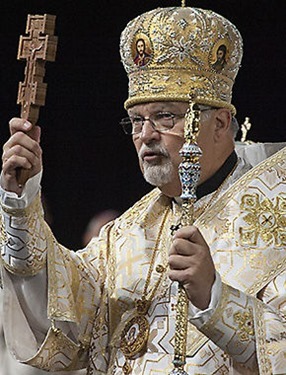
Philadelphia is not only a Latin Rite archdiocese but also Ukrainian Eparchy. So, Archbishop Chaput celebrated the Opening Mass on Tuesday and on Wednesday the “other” Archbishop of Philadelphia, Metropolitan Archbishop Stefan Soroka, celebrated their liturgy. There were nine Ukrainian Catholic bishops present for the Liturgy, which was very impressive.
Another detail from this year’s convention was that we were joined by the Cardinal Archbishop of Lyons, France, Cardinal Philippe Barbarin, who was attending because they are establishing the Knights in France. It was interesting to have them there to because on Monday the Mass was celebrated for families, but it was also the Feast of St. John Marie Vianney, who was from Lyons. 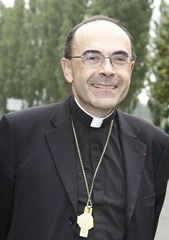
He gave us a copy of this book about the Martyrs of Lyons.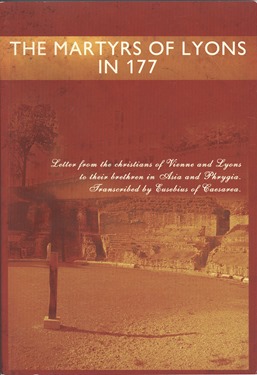
Until next week,
Cardinal Seán
